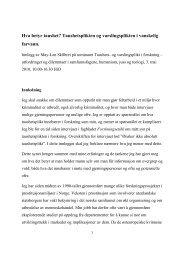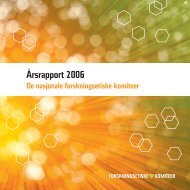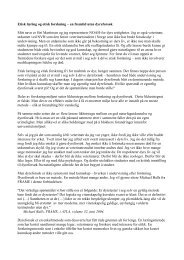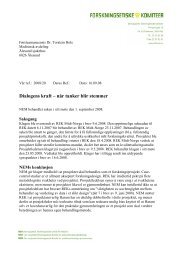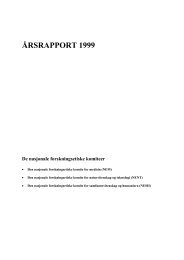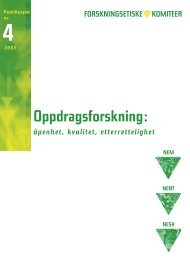Sudbø-saken UiO 2006.pdf - De nasjonale forskningsetiske komiteer
Sudbø-saken UiO 2006.pdf - De nasjonale forskningsetiske komiteer
Sudbø-saken UiO 2006.pdf - De nasjonale forskningsetiske komiteer
Create successful ePaper yourself
Turn your PDF publications into a flip-book with our unique Google optimized e-Paper software.
En slik fordeling av oppgaver vil imidlertid også kunne bidra til at ansvaret pulveriseres.<br />
I Vancouver-reglene er det tatt hensyn til dette, på den måten at det ved publisering i regi av<br />
større forskningsgrupper skal være en eller flere forfattere/medforfattere som tar hovedansvaret<br />
for publikasjonen og prosjektet som helhet, på samme måte som en prosjektleder vil ha<br />
hovedansvaret for planlegging, gjennomføring og avslutning av forskningsprosjektet som helhet.<br />
For fullstendighetens skyld finner kommisjonen det hensiktsmessig å innta de sentrale<br />
bestemmelsene i Vancouver-reglene i sin helhet, slik disse lyder per 1. juni 2006:<br />
“II. Ethical Considerations in the Conduct and Reporting of<br />
Research<br />
II.A Authorship and Contributorship<br />
II.A.1. Byline Authors<br />
An “author” is generally considered to be someone who has made substantive<br />
intellectual contributions to a published study, and biomedical authorship<br />
continues to have important academic, social, and financial implications. (1) In<br />
the past, readers were rarely provided with information about contributions to<br />
studies from those listed as authors and in acknowledgments. (2) Some journals<br />
now request and publish information about the contributions of each person<br />
named as having participated in a submitted study, at least for original research.<br />
Editors are strongly encouraged to develop and implement a contributorship<br />
policy, as well as a policy on identifying who is responsible for the integrity of the<br />
work as a whole.<br />
While contributorship and guarantorship policies obviously remove much of the<br />
ambiguity surrounding contributions, it leaves unresolved the question of the<br />
quantity and quality of contribution that qualify for authorship. The International<br />
Committee of Medical Journal Editors has recommended the following criteria for<br />
authorship; these criteria are still appropriate for those journals that distinguish<br />
authors from other contributors.<br />
• Authorship credit should be based on 1) substantial contributions to<br />
conception and design, or acquisition of data, or analysis and<br />
interpretation of data; 2) drafting the article or revising it critically for<br />
important intellectual content; and 3) final approval of the version to be<br />
published. Authors should meet conditions 1, 2, and 3.<br />
• When a large, multi-center group has conducted the work, the group<br />
should identify the individuals who accept direct responsibility for the<br />
manuscript (3). These individuals should fully meet the criteria for<br />
authorship defined above and editors will ask these individuals to<br />
complete journal-specific author and conflict of interest disclosure forms.<br />
When submitting a group author manuscript, the corresponding author<br />
31





